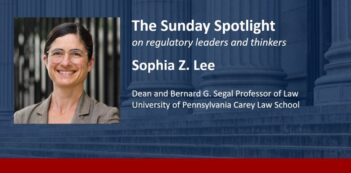
Distinct concepts clarify judicial review of U.S. agency decision making.
The reigning administrative law mystery of the last third of a century, Chevron “deference,” has never seemed especially mysterious, controversial or difficult to me. In trying to work out why Chevron has not seemed difficult to me, I’ve found “deference” at the heart of the confusion.
Justice Stevens, the author of Chevron, captured the problem in a sentence denying the utility of the U.S. Supreme Court’s analogous and equally confusing approach to equal protection issues. Multi-level deference analysis, like “tiers of scrutiny” equal protection analysis, “does not describe a completely logical method of deciding cases, but rather is a method the Court has employed to explain decisions that actually apply a single standard in a reasonably consistent fashion.”
Administrative law scholars have leveled a forest of trees exploring the mysteries of the Chevron approach that contemporary judges take to reviewing law-related aspects of administrative action. Without wishing to deny for a moment that judicial practice has been inconstant – influenced by the importance of the matter, by the accessibility of the issues to non-expert judges, by politics, and by the earned reputations of differing agencies – I suggest an underappreciated, appropriate, and conceptually coherent structure to the Chevron relationship of courts to agencies, a structure whose basic impulse may be captured by the concept of “allocation.”
Steering clear of commonly used review concepts that may muddle rather than clarify the structure’s operation, I avoid the term “deference” and argue that instead of “Chevron deference” and “Skidmore deference,” one could more profitably think in terms of “Chevron space” and “Skidmore weight.”
“Chevron space” denotes the area within which an administrative agency has been statutorily empowered to act in a manner that creates legal obligations or constraints, its allocated authority. “Skidmore weight” addresses the possibility that an agency’s view on a given statutory question may in itself warrant respect by judges who are themselves unmistakably responsible to decide the question.
A simple and rational synthesis of the leading cases can without difficulty be made, if one abandons the confusions of “deference” for the distinct qualities of “weight” and “space.” Agency views of statutory meaning may often be entitled to considerable weight when judges come to decide for themselves issues of statutory meaning. American courts have recognized this proposition for almost two centuries.
More recently, we have come to understand and accept that Congress may vest executive agencies with authority to act with the force of law, so long as the boundaries of that action can be judicially determined. In that space – their Chevron space – the agency is the prime actor, and the very conclusion that Congress has delegated authority to it commands reviewing courts to act, not as deciders, but as overseers.




